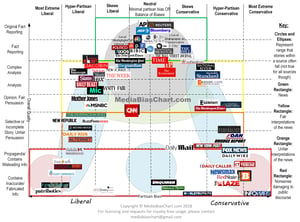Join the InfoLit Learning Community now. Already a member? Log in here.

This week we had the opportunity to chat with Vanessa Otero, creator of the original Media Bias Chart, and discuss some of our most pressing questions about media bias, her news source assessment process, and how we can begin to have these complex conversations with our patrons.
How did you get involved in this work?
I got involved in this work somewhat by accident. As an avid news reader over the years, I became increasingly alarmed in the lead-up to the last election about the kinds of "news sources" people would share on social media in support of their viewpoints, and I realized that many people are ill-equipped to distinguish both quality and bias in news sources. I created the first version of the chart to generate a discussion just among my own peer group. I had no idea it would become so popular! That's why I say it was an "accident." Its huge popularity made me realize that there is a huge space that needs to be filled: the rigorous analysis of what exactly is in our news sources and making the results of that analysis accessible to everyone.
Is media bias a new problem?
No, but its impact is at unprecedented levels, I believe. All journalism organizations have been accused of bias, since the very first newspapers and magazines. As different sorts of print and broadcast media have expanded, so have the opportunities for bias. Talk radio has been a source of biased news for decades now, and about 20 years ago Fox News ushered in the era of overt bias in TV news programming. But the internet and social media have substantially lowered the barriers to providing news, so the number of low-quality and highly biased sources that present themselves as "news" is exponentially greater than it was even 10 years ago. We are truly in a new information environment, and we need to learn how to deal with it.
 How do you decide where a source falls on your spectrum?
How do you decide where a source falls on your spectrum?
This is something I will go over in lots of detail in the webinar. I analyze individual stories on a detailed quality scale and partisanship scale, and the sources are placed as a weighted average of the stories that make them up. The truncated version will be in the presentation, but if people want to read in-depth about the quality metrics, they can read this related blog post.
A first step that I take to assess the quality of every story, though, is to look at how the main graphic, the headline, and the story match up. If one of them seems to be out of line with the others, that's a big down-vote for quality.
Can bias be a positive force?
One of my mentors in the study of this field, I think approaches this subject best. He says we all have to acknowledge that we have biases, even when we are trying not to. Every news organization has to adopt some baseline bias–for example, a financial paper adopts the bias that capitalism is good, or at least normal. Any United States paper adopts the bias that democracy is good. The question is whether bias is appropriate for the medium. If one is writing an opinion piece to advocate for a particular position, and presents it as such, even extreme bias can be appropriate. The problems arise when the bias is inappropriate. For example, if one is presenting programming or writing as "news," but it is actually opinion, that is misleading.
How should librarians approach research with patrons who believe that a more polished presentation signifies untrustworthy elitism, and conversely poor grammar, no citations, etc., means down-to-earth and more likely to be factual?
I think we need to fight for the importance of good writing like we fight for the importance of facts. I don't think this is an area where educators or librarians should acquiesce to a point of view that "error-prone" somehow equates with "trustworthy." Any reasonable set of metrics would most likely prove that the opposite is true. When people are sloppy about spelling, grammar, punctuation, and capitalization, they are likely to be sloppy about underlying research and factual accuracy. How people do one thing often translates into how they do other things. Patrons who themselves don't have good reading or writing skills may object to that statement, reasoning that they can be smart in other areas even if they don't read and write well. That is true. However, written communication is a primary way we convey our ideas to each other. We have to stand up for people being at least proficient in good reading and writing, and we must demand it from those who claim to be telling us the news.
For more information on Vanessa’s work, be sure to tune in live for her presentation as part of the Credo InfoLit Learning Community on April 26. Already a member? Get involved in the conversation here.
